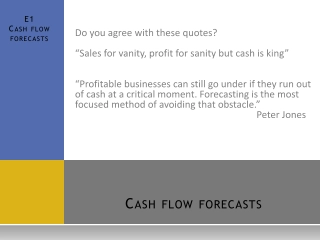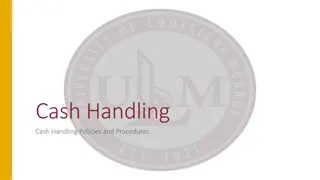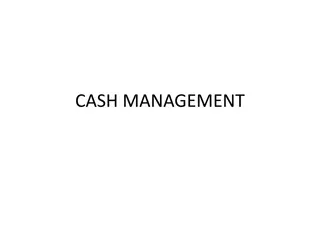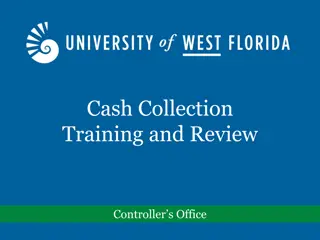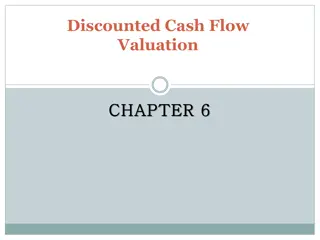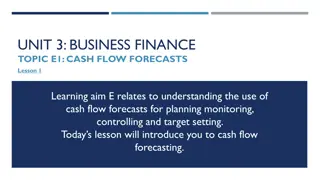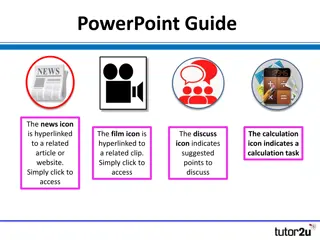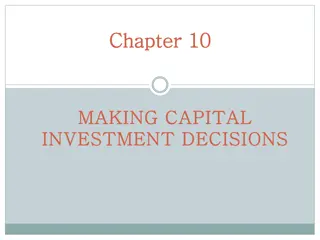Cash Flow Management for Business Success
Cash flow management is vital for ensuring your business's financial health. Learn about working capital, its significance, and how to determine your business's working capital needs. Discover practical examples and tips to navigate cash flow challenges and optimize your business operations effectively.
Download Presentation

Please find below an Image/Link to download the presentation.
The content on the website is provided AS IS for your information and personal use only. It may not be sold, licensed, or shared on other websites without obtaining consent from the author.If you encounter any issues during the download, it is possible that the publisher has removed the file from their server.
You are allowed to download the files provided on this website for personal or commercial use, subject to the condition that they are used lawfully. All files are the property of their respective owners.
The content on the website is provided AS IS for your information and personal use only. It may not be sold, licensed, or shared on other websites without obtaining consent from the author.
E N D
Presentation Transcript
Entrepreneur Entrepreneur Local Learning Centers Local Learning Centers
Understanding Cash Flow (the Working Capital) In seminar 16, we talked about the basics of cash flow management as the tool to help you get ready for slow periods and plan your financing for the busy ones. This seminar will help you understand the importance of your working capital.
What is Working Capital? Working capital is the amount of cash and other assets a business has available after all its current debts or obligations are accounted for. It is also defined as your short-term liquidity or the ability to pay your bills as they are due. Current Asset (cash in): cash in the bank, money owed by clients for services/goods sold (Credit sales), and inventory. Current liabilities (cash out): accounts payable, such as the money owed to creditors, suppliers, vendors, and wages payables The Formula current assets (Minus) current liabilities = Working capital
Working Capital in the Day-to-Day Why is it important? It can help smooth out fluctuations in revenue. For example, many businesses experience some seasonality in sales, selling more during some months than others. However, it would help if you still covered expenses, such as rent, payroll, and municipal taxes, all year round. With adequate working capital, your business can make extra purchases from suppliers to prepare for busy months while meeting its financial obligations during periods where it generates less revenue, and can also help to self-finance growth.
How Much Working Capital Does a Small Business Need? Depending on the line of business, working capital needs may be significant to procure raw materials and labor. To evaluate the necessary sum, the company must pay its current expenses while waiting to collect its profits. We need to assess: Payment delays are your client paying with no delays, or are they paying in 30 or 60 days? What is your average monthly budget? What are the less busy periods for your business? For this section and the following ones, we suggest you follow the excel tables to fully understand the provenance of the data/information.
Working Capital Example Kuujjuaq Colourful Scarves
Working Capital Example Cont d. Click here to reference the previous table. Click here to reference the previous table. Looking at Kuujjuaq Colorful Scarves Monthly Budget / Expenses, we can estimate that the average monthly need in working capital for the last nine months is $5 780$ (not considering the three first months as a Startup). On average, Kuujjuaq Colorful Scarves should consider putting aside 2-3 months ($11 500 to $17 340 ) to ensure coverage of its day-to-day operations cost. Remember: if the company has to close for any unforeseen reason, then the costs of rent, salaries, debts, electricity, insurance, and others still continue to accumulate! Service businesses, on the other hand, rely far less on working capital simply because they can operate with less overhead. Let s take that same example, but with a service company for which the inventory costs are removed; with an average monthly operating cost of $3350 in this case, the working capital could be estimated at $ 6700 to $ 10 500: around 65 % less!
Plan Ahead How Can I do This? Estimating working capital means calculating future working capital. It should be as accurate as possible. A simple way to estimate your working capital is to estimate a regular amount of cash needed to produce goods or services. This includes cash to make recurring payments, cover unexpected costs, purchase basic materials and pay staff. Additionally, create a cash flow forecast so you have insight into what s coming in and going out, so you know how much money you re likely to have in your bank account. By evaluating your working capital needs and maintaining an adequate buffer, you can ensure enough funds to stock up on supplies before a busy month and save and plan for dry times.
Negative Cash Flow If you experience negative working capital, you may have trouble paying suppliers and creditors and difficulty raising funds to drive business. If the situation continues, it may eventually be forced to shut down. Simple solutions to invoices out on time and follow up with customers who haven t paid avoid negative cash flow For more efficient managing of your cash flow, send your If you keep a good cash flow and can pay your suppliers quickly, you're more likely to be able to secure discounts. It makes more sense to seek a long-term loan with low interest to finance major, costly upgrades purchasing, also called fixed assets. You should avoid using working capital to buy equipment, for example.
Solutions for a Negative Cash Flow Who can you contact, and what can you do? To keep your business open you ll most likely need to trim the fat or reduce costs and find another source of income. Some Advice: Look at areas where you can cut costs or reduce your utility usage to lower your monthly bills. If you re renting office space, talk to your landlord to see if they d be willing to reduce rent or renegotiate your lease. Talk to creditors, don t ignore them. The last place you ll want to cut costs is people. If you find yourself in a tough spot, try reducing employee hours and compensation before laying them off. Take a closer look at your inventory to see if you can sell overstock assets for cash.
Final Considerations It's not always easy for entrepreneurs to see how they can improve their cash flow. You should also seek outside help, such as KRG Entrepreneurship Support Measure Fund or Support Measures for Emerging Enterprises Support Measure Fund. They can also find areas of the business where there is room to improve and find ways to generate more cash internally. Negative cash flow usually means they ll need to turn to short-term financing to cover the gap and ensure they can pay the bills, such as a better line of credit. This isn t necessarily an issue for large businesses with easy access to multiple forms of credit. But it can be fatal for small businesses who often pay high interest to access short-term working capital funding. If cash flow is tight, you run the risk of not being able to make the payments on that loan. You don't want to get caught in a common and painful debt trap.
TRUE OR FALSE Working capital is the amount of money available after income taxes. True False True False
Congratulations, you are correct! Income after income taxes = net profit! Working capital is the amount of cash and other assets a business has available after all its current debts or obligations are accounted for. Click here to continue. Click here to continue.
Sorry. Please try again. Click here to try again. Click here to try again.
SELF EVALUATION What are some simple solutions to avoid negative cash flow? A. Actively search for business partners and constantly look for ways to reduce costs in your business, like salaries. A. B. Seek out fast cash in the form of short-term loans to guarantee positive cash flow, and only deal with vendors who give you discounts. B. C. Send your invoices on time and seek long-term loans with low interest to finance major purchases. C.
Congratulations, you are correct! Click here to continue. Click here to continue.
Sorry. Please try again. Click here to try again. Click here to try again.
GLOSSARY Click on the word to go back to that slide. Short-Term Liquidity: Short-term liquidity is the ability of the company to meet its short- term financial commitments. Common types of these short-term commitments include short-term bank loans, accounts payable, wages, lease payments, and income taxes payable. Liabilities: Liabilities are debts that you owe to other people. The only liability in our balance sheet example is a bank loan. But total liabilities can also include credit card debt, mortgages, and accrued expenses such as utilities, taxes, or wages owed to employees.


